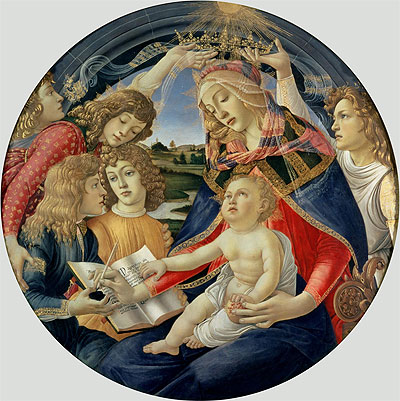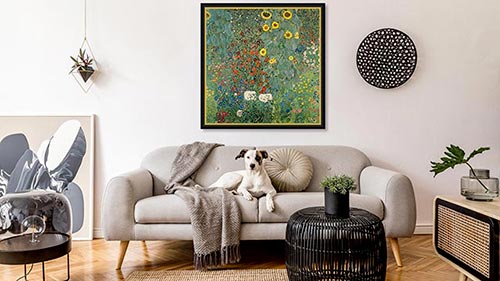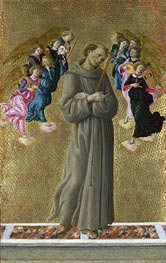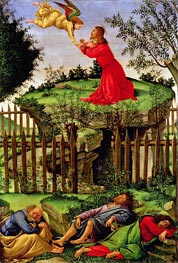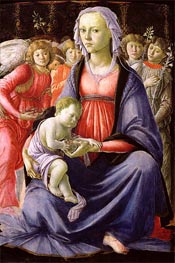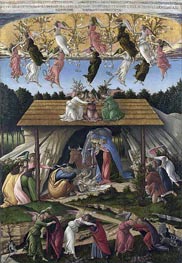Madonna of the Magnificat, 1482 by Sandro Botticelli
Canvas Print - 6250-BSF
Location: Galleria degli Uffizi, Florence, ItalyOriginal Size: 115 x 115 cm
Giclée Canvas Print | $82.79 USD
Your Selection
Customize Your Print
By using the red up or down arrows, you have the option to proportionally increase or decrease the printed area in inches as per your preference.
*Max printing size: 29.9 x 29.9 in
*Max framing size: Long side up to 28"
"Madonna of the Magnificat" will be custom-printed for your order using the latest giclée printing technology. This technique ensures that the Canvas Print captures an exceptional level of detail, showcasing vibrant and vivid colors with remarkable clarity.
Our use of the finest quality, fine-textured canvas lends art reproductions a painting-like appearance. Combined with a satin-gloss coating, it delivers exceptional print outcomes, showcasing vivid colors, intricate details, deep blacks, and impeccable contrasts. The canvas structure is also highly compatible with canvas stretching frames, further enhancing its versatility.
To ensure proper stretching of the artwork on the stretcher-bar, we add additional blank borders around the printed area on all sides.
Our printing process utilizes cutting-edge technology and employs the Giclée printmaking method, ensuring exceptional quality. The colors undergo independent verification, guaranteeing a lifespan of over 100 years.
Please note that there are postal restrictions limiting the size of framed prints to a maximum of 28 inches along the longest side of the painting. If you desire a larger art print, we recommend utilizing the services of your local framing studio.
*It is important to mention that the framing option is unavailable for certain paintings, such as those with oval or round shapes.
If you select a frameless art print of "Madonna of the Magnificat" by Botticelli, it will be prepared for shipment within 48 hours. However, if you prefer a framed artwork, the printing and framing process will typically require approximately 7-8 days before it is ready to be shipped.
We provide complimentary delivery for up to two unframed (rolled-up) art prints in a single order. Our standard delivery is free and typically takes 10-14 working days to arrive.
For faster shipping, we also offer express DHL shipping, which usually takes 2-4 working days. The cost of express shipping is determined by the weight and volume of the shipment, as well as the delivery destination.
Once you have added the paintings to your shopping cart, you can use the "Shipping estimates" tool to obtain information about available transport services and their respective prices.
All unframed art prints are delivered rolled up in secure postal tubes, ensuring their protection during transportation. Framed art prints, on the other hand, are shipped in cardboard packaging with additional corner protectors for added safety.
Painting Information
Botticelli’s "Madonna of the Magnificat" presents a mesmerizing fusion of the divine and the worldly - a meeting of earthly grace and heavenly elegance. Painted within a tondo format, this circular frame is not merely a stylistic choice but a narrative device, drawing the viewer into an endless, unbroken scene that mirrors the eternal nature of its sacred subjects. Here, Mary, crowned by angels, pens the words of the "Magnificat" with delicate assistance from the Christ Child on her lap. The act is both tender and profound, underscoring Mary’s role as both mother and holy intercessor, while the Christ Child’s grip on a pomegranate subtly foreshadows the blood he will one day shed. Botticelli has imbued every element with symbolic depth, yet the painting remains remarkably accessible – both a portrait of the Madonna and an intimate scene of mother and child.
The color palette is at once lavish and harmonious, creating a serene luminosity that emanates from within the composition. Botticelli’s reds and blues are deep yet softened, lending warmth to the scene without overwhelming it. Mary’s robe, trimmed in elaborate gold, is radiant, yet it never disrupts the calm poise of her expression or her figure. Her attendants – the angels – are dressed in fabrics that evoke the luxurious fashions of Florence’s nobility, their golden hair painted with such delicacy that it almost gleams. This contrast between the otherworldly and the familiar is central to Botticelli’s work, hinting that the divine may not be so far removed from the earthly. Even the landscape glimpsed through the window – a quiet, rolling countryside bathed in daylight – situates these holy figures within a world that is not altogether alien to the viewer.
The brushwork is impeccable, Botticelli’s hand steady and light, his layering of paint achieving a level of translucency that gives the figures an ethereal quality. Mary’s veil, for example, appears almost weightless, as if woven from air itself, while the folds of fabric ripple and fall with a natural grace. Botticelli’s sensitivity to texture is remarkable, each stroke applied with care, creating an intricate interplay of light and shadow that brings out the faces of the figures with softness and warmth. The angels, too, are painted with extraordinary detail; their faces are young, idealized, and yet somehow intensely present, their expressions absorbed and intent as they participate in this holy moment.
In the composition, Botticelli achieves an almost dance-like harmony. The circular format encourages a seamless, continuous movement of the eye around the scene, each figure drawing attention in turn without jarring interruptions. This is no static scene – there is a dynamic relationship between Mary and the angels, as well as between the sacred figures and the viewer. The lack of traditional angelic wings further blurs the boundaries between heaven and earth, hinting at a divine presence that permeates everyday life. The angels, with their luxuriant curls and fashionable attire, are remarkably human in their appearance, almost like noble children from a Florentine palace, rather than distant, ethereal beings.
Originally, this tondo was most likely intended for a private residence or civic space, an art piece to be treasured within a secular environment rather than a church. In Renaissance Florence, such formats were common for artworks commissioned on significant occasions like weddings or births, yet Botticelli elevates this custom to a level of near-universal beauty. Through "Madonna of the Magnificat," Botticelli does not merely depict a scene of religious devotion but offers an invitation to witness the coexistence of the sacred and the mundane, realized with all the elegance and refinement of his inimitable touch.
